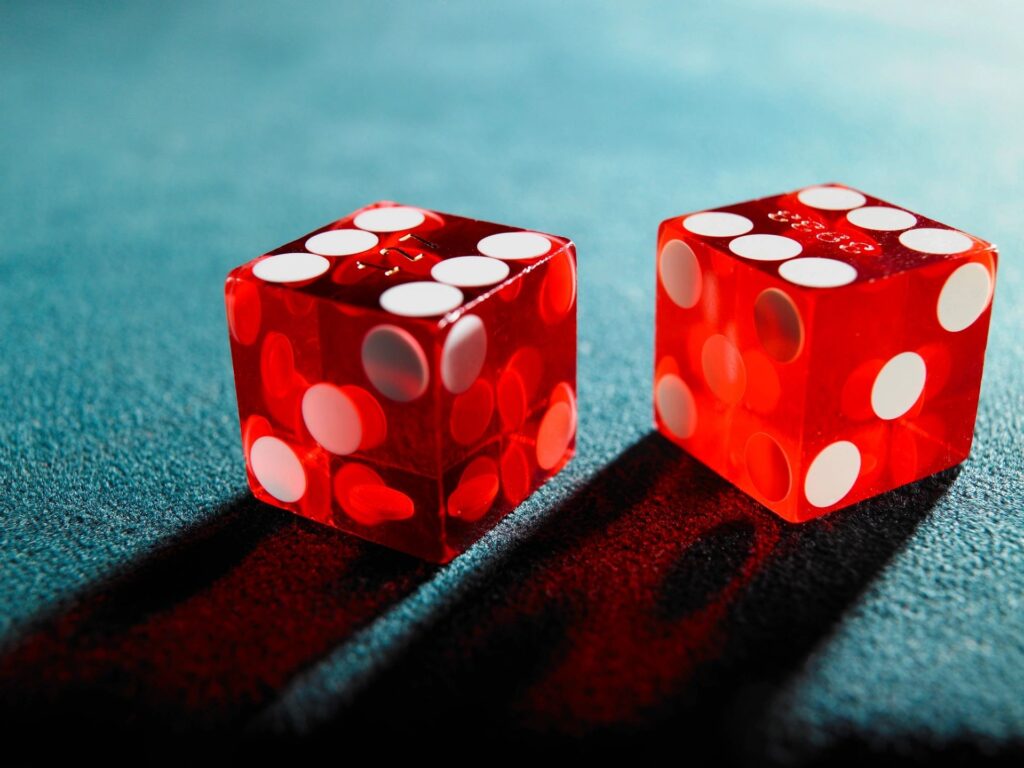
When it comes to Bets & Outcomes with money, whether a bet is a good choice to make, the risk and chances should be calculated first. It gives a good overview of what is currently going on with the investment and what might be possible from this point. In many cases this calculation is a probability. That means nothing is certain, there is only a certainty “level”. This is written down as a percentage part out of 100. The result is called an expected value (EV).
Positive Example (deterministic):
The investment game consists of a bet of 100$, which you can win or lose, every time you make it. There is a chance to win (in 60% of all cases) and a risk to lose (in 40% of all cases).
Bet = 100$
Winning 100 $ percentage = 60%
Losing 100$ percentage = 40%
Should you make this bet from a mathematical perspective?
Chance
Yes. Make this bet. You will be a winner. Let’s look at the expected value (EV).
EV = (0.6 * 100$) – (0.4 * 100$) = 20 $
For every bet you make the outcome is positive 20$. So, bet as much as you can as often as you can! After this mathematical calculation, let’s have a look at the risk.
Risk
The risk is not losing your bet of 100$, or in average even winning 20$. The risk is connected to what you can afford. If you have 100.000 $ in cash, you can easily afford to lose 100$ many many times and you can be sure you will win it back in the long run (many many bets). If you have only 100$ in cash is it intelligent to make this bet? The number of times you can play might be lower. Let’s see the calculation.
Probability of total loss (Game over) with 100$ available
- round 1: 0.4 (40%)
- round 2: total loss impossible (Win 100$, then lose 100$, or Win 200$)
- round 3: 0.4 + 0.6*0.4*0.4 = 0,496 (49.6%)
- round 4: total loss impossible (Win 200$, then lose 200$, or mix of both)
- round 5: 0.4 + 0.6*0.4*0.4 + 0.6*0.6*0.4*0.4*0.4 + 0.6*0.4*0.6*0.4*0.4 = 0.54208 (54,208%)
Probability of total loss (Game over) with 500$ available
- round 1: total loss impossible (if you lose, 400$ are still available)
- round 2: total loss impossible
- round 3: total loss impossible
- round 4: total loss impossible
- round 5: 0.4*0.4*0.4*0.4*0.4 = 0,01024 (1,024%)
What this means:
When there is only 100$ cash available (ALL-IN situation), the biggest “enemy” of this bet is round 1. The chance is already high (40%) that there is a total loss. After this loss other things might follow, because real life is not over. One must go borrowing money or working. Who will lend money? Who will give you a job? That is the non-mathematical risk to remember and to check before making this kind of bet. The mathematical risk to have a total loss after round 5 is higher than 50% (54,208%). The chance not being out of the game after round 5 is 45,792%. Clearly, the probability of winning long term here is a different case than with 500$ available. Having only 100$ available is a big risk. With 500$ suddenly the risk of game over is very low (1,024%). It is the exact same thing with higher $$$ numbers. Important to notice is that this is the calculated risk with a certain probability. The key of this betting game is to stay in the game long term, because it is a positive bet (The EV is positive). It is therefore recommended that there is enough cash reserve to “survive” the rounds at least a number of times when making such a bet.
Also, important to notice is that online bets (sport, casino, etc.) is not in favor for winning. Simply, the EV is negative and that is how a casino earns money. In a casino positive bets are not available.
Negative example (deterministic):
Bet = 100$
Winning 100$ percentage = 40%
Losing 100$ percentage = 60%
Should you make this bet from a mathematical perspective?
Chance
No. Do not make this bet. Let’s look at the EV.
EV = (0.4 * 100$) – (0.6 * 100$) = -20 $
For every bet you make the average outcome is minus 20$. Your chance is already negative long term.
Risk
There is no requirement to calculate the risk. This is a bad game. Don’t make any bet unless you like losing.
But ok let’s calculate a game over situation:
Probability of total loss (Game over) with 100$ available
- round 1: 0.6 (60%)
- round 2: total loss impossible (Win 100$, then lose 100$, or Win 200$)
- round 3: 0.6 + 0.4*0.6*0.6 = 0,744 (74.4%)
- round 4: total loss impossible (Win 200$, then lose 200$, or mix of both)
- round 5: 0.6 + 0.4*0.6*0.6 + 0.4*0.4*0.6*0.6*0.6 + 0.4*0.6*0.4*0.6*0.6 = 0,81312 (81,312%)
Probability of total loss (Game over) with 500$ available
- round 1: total loss impossible (if you lose, 400$ are still available)
- round 2: total loss impossible
- round 3: total loss impossible
- round 4: total loss impossible
- round 5: 0.6*0.6*0.6*0.6*0.6 = 0,07776 (7,776%)
Example (non-deterministic)
What to expect, if the risk (loss) and chance (win) is not certain?
One solution could be to assume the probabilities, e.g. a price rise or fall and to make an assumption based on facts. The problem with this kind of solution is that facts are also known by the market. The market prices might therefore not be very favorable. The calculation of the EV (expected value) with this bet is the same as above.
A second solution is gut feeling. If the bet / investment is too complex and facts are hardly available, good assumptions might be impossible. In that case the market participants know as much as you and automatically the chance of winning a lot can be higher. Usually this is the case with speculative bets in the stock market. Still assumptions must be made, even by dreams.
A third solution is the believe in and count on the human stupidity. Even when the market could know what the facts are, fellow human investors might act stupid simply because they do not calculate anything or they don’t know what they are doing in general. Robo investors also might be very stupid, because human stupidity is programmed into a software. If the human stupidity is connected to the bet or sits within the investment (dumb management, Donald Trump style), anything can happen. Then, I usually assume a 50-50 chance / risk. The more stupid, the higher is the risk. Then the winning prize must be a multiple of the risk of loss.
The next step is to remember the topic of Bets & Outcomes and apply it to your daily “bets”.

Pingback: Should you buy lots of stocks / bonds? – YepInvest
博主你好,你的网站做得真好,可以跟你换个友链吗?
Please use the contact form